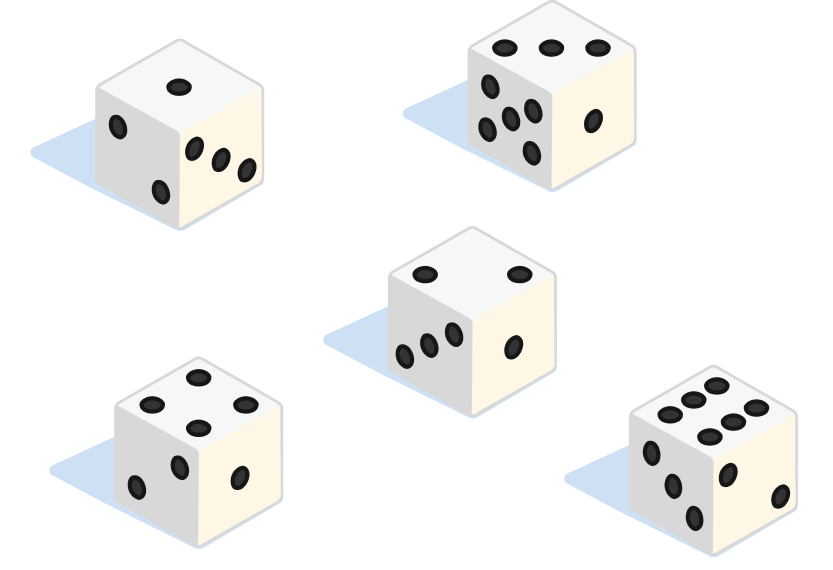The anti-Yahtzee
When rolling five 6-sided dice, what is the probability of rolling all different numbers?

This section requires Javascript.
You are seeing this because something didn't load right. We suggest you, (a) try
refreshing the page, (b) enabling javascript if it is disabled on your browser and,
finally, (c)
loading the
non-javascript version of this page
. We're sorry about the hassle.
2 solutions
@Andy Hayes Sorry, you must have posted your solution while I was in the process of writing mine, for when I started yours wasn't up yet. Our methods are slightly different, though, so for sake of variety I'll leave mine up.
In Yahtzee one can accumulate points via a "small straight", (precisely 4 sequential dice), or a "large straight", (precisely 5 sequential dice). So if it is given that we have rolled 5 different numbers, there is a 3 1 probability of getting a small straight, ( ( 1 , 2 , 3 , 4 , 6 ) or ( 1 , 3 , 4 , 5 , 6 ) ), a 3 1 probability of getting a large straight, ( ( 1 , 2 , 3 , 4 , 5 ) or ( 2 , 3 , 4 , 5 , 6 ) ), and a 3 1 probability of getting nothing, (( 1 , 2 , 3 , 5 , 6 ) or ( 1 , 2 , 4 , 5 , 6 ) ).
(These last two rolls could be counted as "Chance" scores. I played this game often as a kid, but I didn't know anything about probability theory back then. There are plenty of potentially difficult questions that can be posted based on this game, particularly when one brings in the fact that each turn can involve the initial roll and two allowed re-rolls that involve any number of the 5 dice.)
Log in to reply
No, it's good that you wrote that solution, because I was considering something similar as well. In fact, I gave your solution an upvote.
I'm thinking of a couple more Yahtzee problems, and the kind of approach you outlined will become more appropriate :)
Log in to reply
Great! I look forward to giving your upcoming problems a try. :)
For the purposes of calculating the desired probability it may be easiest to consider the 5 dice as distinguishable. With this in mind, there are 6 5 possible outcomes when rolling the 5 dice, as each individual die has 6 outcomes.
Now there are ( 5 6 ) = 6 possible combinations of 5 numbers chosen from the set { 1 , 2 , 3 , 4 , 5 , 6 } . For each of these combinations we can assign the 5 numbers to the 5 distinguishable dice in 5 ! = 1 2 0 ways. Thus the desired probability is
6 5 6 ∗ 1 2 0 = 6 3 2 0 = 8 ∗ 2 7 4 ∗ 5 = 5 4 5 .
Each succeeding dice roll should be different. The first roll can be any of the six numbers, there are 5 possibilities for the second roll, 4 possibilities for the third roll, and so on.
The probability is: 6 6 × 6 5 × 6 4 × 6 3 × 6 2 = 5 4 5 .